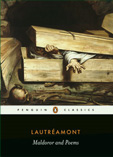A dung-beetle rolls along the ground an excremental ball whose crushed elements are the limbs of a woman. A shadowy tormentor lets his nails grow for a fortnight in order to drag from his bed a child with no hair on his upper lip. A young girl chases butterflies through a summer meadow before unexpectedly having to say goodbye to life's enchantments following a double sexual assault by a man and his bulldog.
Maldoror is present in all of these scenes and yet he is also strangely absent. The violence in these scenes has a shocking immediacy, and yet it is presented with such irony. The events in these scenes are harmonious and each clause follows on from the last, but to say that they make sense would be an overstatement. The book is filled with truths, but truths born from aberration, from error. The diverse contents of Maldoror's stories and the complexities of Maldoror's form present several difficulties. Who is Maldoror, and what does he want?
The characters in Maldoror are in no way comparable to those of the typical 19th century novel in which a clearly defined character attains maturity in accordance with the law of assured development. Maldoror's characters are much more fluid, and their transformations more complex, than the tepid psychological-moral growths of the Bildungsroman protagonist. Far from being a series of clearly-defined entities, Maldoror's characters are more like the masked 'types' of commedia dell'arte, where each 'type' is a recurring melody or motif, which returns at various points in order to embody a particular psychological or emotional mood — the principal 'types' in Maldoror being God, Maldoror, and man (God and Maldoror locked in combat, man a dumb spectator).
God returns in various guises throughout the book, and although he is the official representative of the Christian religion, he also embodies a more general tendency — for Lautréamont, God is the ultimate embodiment of Illegitimate Authority. His face reddens like a burning coal at the most trivial misdemeanours of men... his sneering scalpel probes the undergrowths of consciousness... when Maldoror raises his pen to compose his thoughts, God sends a thunderbolt that cuts his forehead in two. God is the spirit of surveillance who limits action and debases all forms of activity (not just religion), who inaugurates self-denial in the field of action, self-abasement in the field of thought, the obeying of imperatives in the field of morality, strictly-defined categories in the field of science, representation in the field of art, and perhaps most importantly — the 19th century novel in the field of literature.
The thing which characterises Maldoror and which differentiates it from conventional fiction is its use of metaphor. Metaphor in conventional fiction is like the spike on the polygraph which indicates that the author is lying, ascending temporarily from the literal baseline of the text through a fanciful comparison or poetic departure, before crashing back down to reality just a few seconds later. In Maldoror a metaphor is introduced as a comparison but the author forgets that the metaphor was meant to be comparative and it becomes so compelling that it constitutes the reality of the scene — the game ascends to another plateau, and a new baseline is established for further departures. Maldoror's harmonious dreamscapes flow into metaphors as if they were literal, incorporating aberrations and building on them.
If the book is filled with violence, it is because violence is a form of Becoming which explodes embodied assumptions in its creation of new forms (reflecting the expansive construction of the text). It is for this reason that a moral interpretation of the book is not very useful, because unlike the 19th century novel, the parables in Maldoror do not contain any lessons — or rather, the lessons they contain are not to be found in the words, but in the creative force of a whirlwind which uproots embodied assumptions and spews them out centrifugally over the landscape.

